After the first steel-built ironclads, the Devastation class, which were still central battery ironclads, the Marine Nationale returned to the “near-turret” concept after the Ocean class with a central battery sporting four upper heavy guns in open barbettes. But she was specifically designed as a barbette ship, meaning the main guns were placed only in barbettes, in that case, four 340 mm (13.4 in) guns with better individual arcs of fire. Amiral Duperre remained single in class, but was mostly an answer to a public outcry in France after the Regia Marina unveiled the Duilio, and then Italia class sporting gigantic 45 cm guns, also worrying the British Royal Navy. Duperré acted as prototype for the new Bayard and Amiral Baudin classes.
She remained in the Mediterranean Squadron, taking part in numerous training exercises but suffered an accidental explosion on one main gun. Placed on the reserve Division in 1895 as flagship she was eventually transferred in 1898,to the Northern Squadron, withdrawn in 1901, and modernized until 1905 and stricken in 1909, BU in 1910.
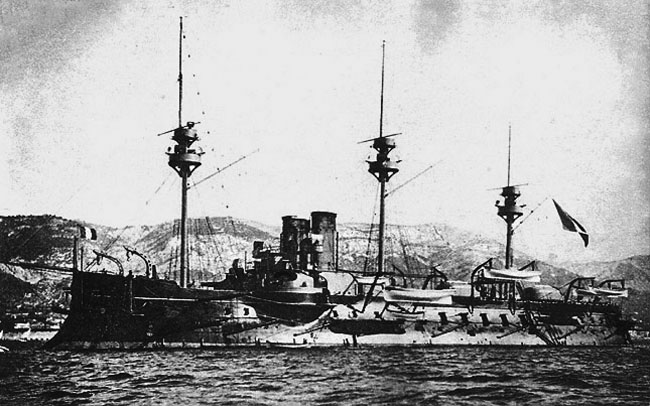
Amiral Duperré in 1888
Development
The defeat of France in the war of 1870-71 and enormous indemnity paid to Germany meant the naval budget was severely restrained, albeit this never prevented some innovation in design. A construction program to strengthen the fleet started in 1872 and initially was a continuation of older designs, but by the 1870s the new French design staff established as the Conseil des travaux (Board of Construction) wanted to embrace the latest technological developments and look at foreign designs. France focused on land to the German threat, and on the seas, to the RN, but eventually the unification of Italy and naval ambitions led to look further at the Italian Regia Marina expansion program, masterfully led by Benedetto Brin. Soon, Italy embarked on a program to build very large ironclads that can gain for Italy at least on paper the mastery of the Mediterranean.
The Duilio and Italia classes both sported guns of a calibre never approached by any other navies, as they were as armed with 100-tons, 450 mm (17.7 in) naval guns. On paper, they could defeat any armour, and outrange any gun sported by Austrian, French or British ironclad at the time.

The French naval staff initially was not worried much by these ships, arguing notably of the expected very slow rate of fire and impracticality of these massive guns. But in 1877, the press relayed a public outcry over these new Italian vessels. This flared up at the Assemblée nationale (Parliament) and the Navy was pressed to react. Since the four ironclads were barbette ships, sporting four guns each, the Navy came out with a design which became the Amiral Duperré. Notably a departure from former naval guns, 320 mm (12.6 in) 20-caliber M1875 used for the Devastation class, and pressed for the design of new steel guns that could compete at least in terms of range. A re-boring of the 320 mm to 340 mm (13.4 in) with a new jacket and longer tube brought another Modèle 1875, that can at least approach the range of the Italian guns, albeit still “light” in terms of calibre. They were installed first aboard Amiral Duperré, literally built around four barbettes with this new ordnance.
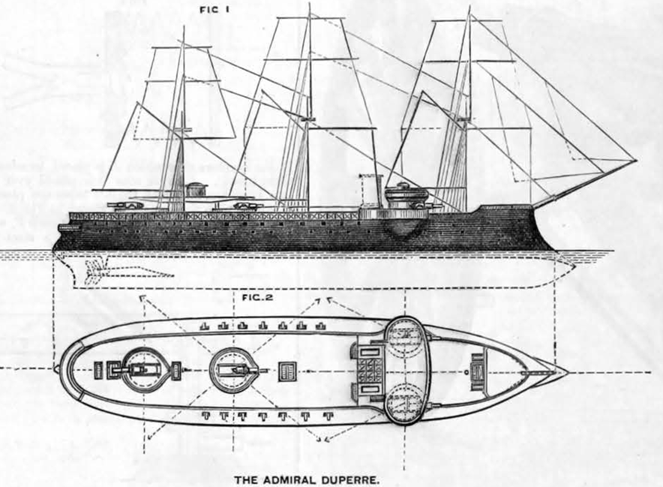
In time, the design also evolved to offer a better protection against the effects of these 45 cm naval guns, and the first reflex was to choose a thicker armour, but with a concession, to drop the full side armour scheme of earlier ironclads and restrict it to more vital areas, to preserve displacement. Intense discussions over this chapter were not restricted to France either, it was a worry for all nations now that a race was seemingly on for larger naval guns. French designers called this concession in protection the “décuirassement” literally “un-armouring” which consisted in eliminating most of the side armour, limited to the belt only, and concentrated to the perimeter of the barbettes.
The latter, due to the height of their placement, were lightly armoured to preserve stability. The French Naval doctrine at the time, still obsessed by the battle of Lissa, was to privilege manoeuvre first. They considered the unarmoured ends of the citadel ships could be easily damaged and flooded, and still saw the ram as the decisive weapon. So the approach was radically different from the British or Italian navies, leading to shorten the belt armour to save weight and make the remaining central armour much thicker.
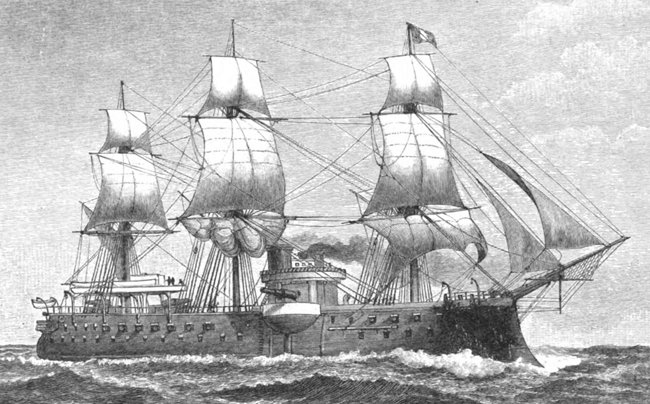
Work was started under Naval Minister Charles de Dompierre d’Hornoy’s and the Conseil des travaux was tasked to prepare two options for the new battleship “de première classe” on 20 October 1873. Director Victorin Sabattier drafted one option combining both barbettes and a central battery, leading to the steel-built Dévastation class while the other with all heavy guns in barbettes on the upper deck was further altered until submitted to the new navy minister Léon Martin Fourichon on 8 March 1876, so three years later. Fourichon approved it on 5 August and a contract was awarded on 4 December to Société Nouvelle des Forges et Chantiers de la Méditerranée (FCM). The design was a virtual copy of the Devastation, also in steel, but with a main battery arrangement in barbettes. This latter led to near repeat class, with the Amiral Baudin and all the 1880s developments, as well as the smaller Bayard and Vauban classes made for overseas deployments, being essentially scaled down versions.
Design of the class
Hull and general design
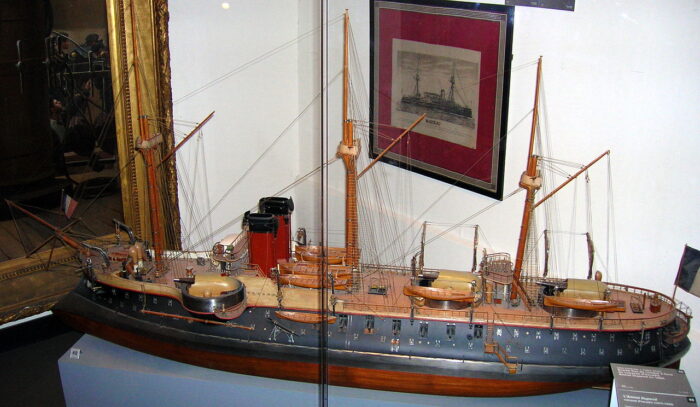
Amiral Duperré was 96.97 m (318 ft 2 in) long at the waterline, but 101.6 m (333 ft 4 in) overall, not counting the bowsprit, with a greater waterline and shorter, narrower upper deck, pear-shaped hull. The beam was 20.4 m (66 ft 11 in), draft 8.43 m (27 ft 8 in) aft (max). To compare, the Devastation class were slightly shorter at 100.52 m (329 ft 9 in) but beamier at 21.26 m (69 ft 9 in) but with a lighter draft at 8.23 m (27 ft). She was also larger in displacement at 11,030 long tons (11,210 t) compared to 10,450 long tons (10,620 t) for the Devastation.
The hull was even more extreme, featuring an even more pronounced ram bow, with a short forecastle deck ending on a stem that was also “spread” to the waterline.
The way the main battery was installed was rather unique, with a forward main battery gun pair, flying bridge between them and a small conning tower placed atop, secondary tower placed aft, between stern barbettes which were in the axis, making a “T” arrangement. The hull was divided by sixteen watertight transverse bulkheads, several longitudinal bulkheads. The pear-shaped hull had a transverse metacentric height of 0.61 m (2 ft) and she sported three pole masts with spotting tops enabling basic fire control correction a voice tubes for her main battery guns, plus two searchlights. She had a crew of 712 officers and enlisted men, more than the Devastation (689) was the hull was busy with a dozen boats of all types under davits, some doubled. The military masts were designed from the start to have a sailing rig, hence their appearance. Drawings showed a barque rigging, but it was only shown on pictures and engraving, never on photos.
Powerplant
Amiral Duperré was powered by two vertical compound steam engines, each running three cylinders and responsible for its own screw propeller. This arrangement was preferred for agility. Steam was generated by twelve coal-burning fire-tube boilers. They were vented through two large funnels side-by-side amidship, aft of the conning tower. The power plant was rated for an output of 7,500 indicated horsepower (5,600 kW) combined, which was less than for the Devastations (8,300 ihp). The latter were rated for 15 knots and managed 15.5 on trials, but without surprise, this was less stellar for the Duperré, as on her initial trials of 1882, out of 7,357 ihp (5,486 kW) her top speed only reached 14.3 knots (26.5 km/h; 16.5 mph) for a contract speed of 14 knots. Coal storage was 787 long tons (800 t), so with a cruising speed of 10 knots (19 km/h; 12 mph) this translated to 2,850 nautical miles (5,280 km; 3,280 mi). This was less than the 3,100 nmi (5,700 km; 3,600 mi) of the Devastations. Amiral Duperré as said above came out with a three-masted barque, then modified as a schooner rig for long crossings, but it was apparently removed before completion and only existed on publications of the time.
Protection
The Devastations had a new armour scheme which included steel, lighter but stronger than wrought armour, albeit it was in limited quantities, so the Amiral Duperré, still high freeboard barbette ship, returned to a more classic scheme of wrought iron armor, with only local inserts of steel, explaining why she was heavier. Here is the detail:
Belt: Full length, 0.46 m (1 ft 6 in) above, 2.01 m (6 ft 7 in) below wal. 559 mm (22 in) thick amidships, 406 mm (16 in) bottom edge, 254 mm (10 in) ends.
Lower belt: 152 mm (6 in) section down at the bow to reinforce the ram.
Armor deck: Connecting the belt on top, 61 mm (2.4 in) mild steel over 18 mm (0.7 in) WI plating.
Barbettes: 305 mm (12 in) thick, tubes 100 mm (4 in).
Gun shields: 51 mm (2 in).
Conning tower: 38 mm (1.5 in) in mild steel.
Conway’s All The World’s Fighting Ships notes she was very vulnerable above the waterline and could have been defeated by her contemporary HMS Inflexible.
Armament

340mm/18 M1875 (13.4 in)
Her main armament comprised four 340 mm (13.4 in), of 18-caliber in individual barbette mounts in a “T” with two side-by-side forward, one amidship, one aft in the axis. Unfortunately, as they were designed in a rush as improved 320 mm, they kept the same loading system and had a very low rate of fire of 7-15 minutes, actually similar or superior to the Italian 450mm guns. They used a pressurized water mechanism for training and elevation, so basically an early hydraulic system that can be vulnerable to shrapnel. The loading was long as it imposed a return to the centreline for reloading, and the hydraulic system could only power one gun at a time, severely limiting the whole effectiveness of the battery. At 18 caliber they were also outranged.
These were the same guns as on the Devastation class, albeit her sister Courbet was completed with the new 21-caliber M1881 variant.
Unfortunately, no data on these guns.
France would have a true equivalent to the Italian guns with the Canon de 42 cm modèle 1875 amade by Ruelle Foundry but it was limited to the four ships of the Terrible-class. Also for the next ironclads were developed the 340mm/28 Modèle 1881 gun which improved on range, from the Marceau class onwards and Hoche. When no in use, the barbettes were covered by a tarpaulin from the elements. They used powder charges that were subjected to decay, explaining the explosion in one of these guns later in her career.
163 mm (6.4 in)/28 M1881
The secondary battery was unusual as there was a single secondary gun of this calibre, on an individual pivot mount in the bow as chase gun with a limited arc of fire. No data.
138 mm (5.4 in)/21 M1870
Fourteen of these were placed in individual pivot mounts on the broadside, completely unprotected, not having even light shields. This made the gun battery of the main deck, seven guns per broadside, very vulnerable, in addition to being of limited fire arc. No data.
37mm/20 Hotchkiss M1885
These were added later in an upgrade. These twelve 37 mm (1.5 in) 1-pounder Hotchkiss revolver cannon were mounted in individual mounts on the military masts’ fighting tops, coving all angles. They were subjected to the ship’s slow roll, which required good training to achieve accuracy. Each gun needed a single crewman but two more bringing up rounds, these cramped tops were quite busy and noisy.
Torpedo Tubes
The Amiral Duperré, like other ironclads before her, came out with four 356 mm (14 in) torpedo tubes in above-water mounts, two on each broadside, one pair ahead and one pair astern.
Modifications
In 1887, with six more Hotchkiss 37 mm guns were added (18), and two more search lights.
In 1892, three main battery guns were replaced by the 21-caliber M1881, the shorter one was likely kept amidship aft. The light battery comprised two 65 mm (2.6 in) guns, two 47 mm (1.9 in) 3-pdr Hotchkiss guns, sixteen 37 mm guns and torpedo tubes now of the M1885 model.
In 1895, new 340mm M1885 were fitted, the 138.6 mm were replaced by 100 mm (3.9 in) guns. The 47 mm guns were removed, four more 65 mm added. Masts reduced to two, but sporting two fighting tops each, one above the other.
Amiral Duperré was modernized in 1901, focusing on new water-tube boilers and engines overhauled. The centre 340 mm gun was removed, and at last an armoured battery for her 163 mm guns was installed. But she was kept in reserve for only a few years in that configuration.
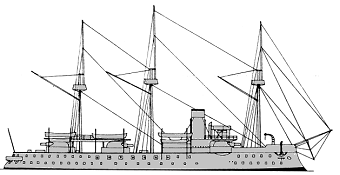
Conway’s profile
⚙ specifications as built 1882 |
|
| Displacement | 11,200 tonnes |
| Dimensions | 97.48 x 20.4 x 8.43 m (319 ft 10 in x 66 ft 11 in x 27 ft 8 in) |
| Propulsion | 2 shafts compound steam engines; 12 × fire-tube boilers: 7,300 ihp (5,400 kW) |
| Speed | 14 knots (26 km/h; 16 mph) |
| Range | 787t coal, 2,800 nm/10 kts |
| Armament | 4× 340 mm (13.4 in), 1× 163 mm (6.4 in), 14× 138 mm (5.4 in) |
| Protection | Belt 254-559 mm (10-22 in), Barbettes 305 mm (12 in), Gun shields 51 mm (2 in), CT 38 mm (1.5 in) |
| Crew | 660-720 (flagship) |
Career of the Amiral Duperré
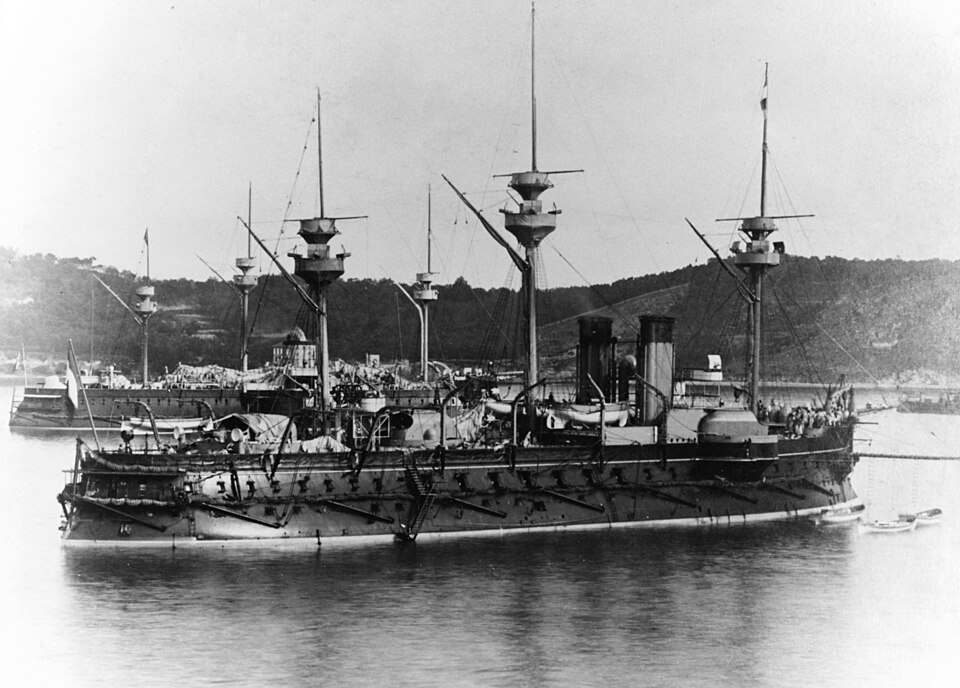
Her keel was laid down at the Société Nouvelle des Forges et Chantiers de la Méditerranée shipyard, La Seyne-sur-Mer near Toulon, by January 1877. She was named after Napoleonic Admiral Admiral Guy-Victor Duperré, wich led the French naval forces in the Mauritius campaign of 1809–1811 victory at the Battle of Grand Port in 1810.
She was launched on 11 September 1879, fitted-out until completion on 11 May 1881, placed in limited commission for her trials with just 99 men on board until 20 November 1882. She was in full commission from 17 April 1883, and joined the Mediterranean Squadron in Toulon. On 2–3 March 1886 she experimented with torpedo boats (as target ship) to determine their effectiveness at all attack angles. On 3 March she joined fellow ironclads Colbert, Friedland, Redoutable, Suffren, Dévastation in a shooting exercise, blasting the old ironclad Armide as target. They tested ideal battle ranges of 2,700 to 4,600 m (3,000 to 5,000 yd), scoring 22% hits with cast iron practice shells, albeit this was in unrealistic conditions. In large-scale manoeuvres off Toulon from 10 to 17 May, she was again tested against torpedo boats and cruisers, in a scenario in which they attempted to break an ironclad blockade.
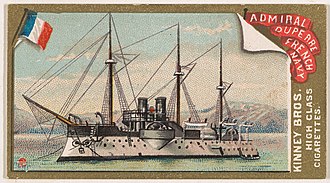 She had also large scale exercises on 2-12 June off Ajaccio (Corsica), simulating an attack on the port, defended by a coastal defence ship, three cruisers, and 20 torpedo boats. Next she was sent for more manoeuvres at Oran, French Algeria, from 25 June, simulating an enemy fleet through the Strait of Gibraltar to attack the French Mediterranean coast (so likely British). They were intercepted by torpedo boats off Majorca. Conditions were rough and these failed essentially, so the lesson was to create larger high seas TBs. However, they still posed a threat to blockading warships. Amiral Duperré had maintenance and repairs on her boilers until 1887.
She had also large scale exercises on 2-12 June off Ajaccio (Corsica), simulating an attack on the port, defended by a coastal defence ship, three cruisers, and 20 torpedo boats. Next she was sent for more manoeuvres at Oran, French Algeria, from 25 June, simulating an enemy fleet through the Strait of Gibraltar to attack the French Mediterranean coast (so likely British). They were intercepted by torpedo boats off Majorca. Conditions were rough and these failed essentially, so the lesson was to create larger high seas TBs. However, they still posed a threat to blockading warships. Amiral Duperré had maintenance and repairs on her boilers until 1887.
In May, she was in exercises of convoy escort to and from French North Africa. The scenario envisioned bringing back troops from Africa to France in case of a major war with Germany. In this, she was joined by Colbert, Courbet and Indomptable. Opposed by a “red” squadron of cruisers and torpedo boats. Bad weather allowed to make the passage, as heavy seas prevented the torpedo boats so even try.
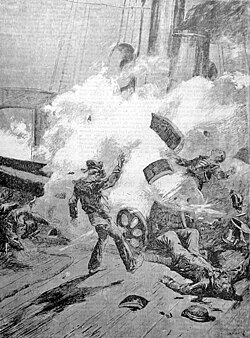 At some point in a gunnery exercise, she had a gun accidentally exploding, albeit reports remained shaky on how it happened. Her breech blew up, and the Naval Annual at the time reported the explosion of 13 December 1888, which killed six men placed the blame on decaying brown powder propellant charge. There could have been also a defect in the steel breech, since she carried first generation steel-built guns. Fording mastery of steel remained deficient as a science until post-WW2 essentially. Historian Theodore Ropp believed this was due to the propellant charge. There were other major incidents involving these later, notably caused by heat and improper storage (like too close from boilers) and management. In time a more effective, slower-burning propellant was developed but for this, there was the need to bore out chambers of existing guns and led in that case to failure.
At some point in a gunnery exercise, she had a gun accidentally exploding, albeit reports remained shaky on how it happened. Her breech blew up, and the Naval Annual at the time reported the explosion of 13 December 1888, which killed six men placed the blame on decaying brown powder propellant charge. There could have been also a defect in the steel breech, since she carried first generation steel-built guns. Fording mastery of steel remained deficient as a science until post-WW2 essentially. Historian Theodore Ropp believed this was due to the propellant charge. There were other major incidents involving these later, notably caused by heat and improper storage (like too close from boilers) and management. In time a more effective, slower-burning propellant was developed but for this, there was the need to bore out chambers of existing guns and led in that case to failure.
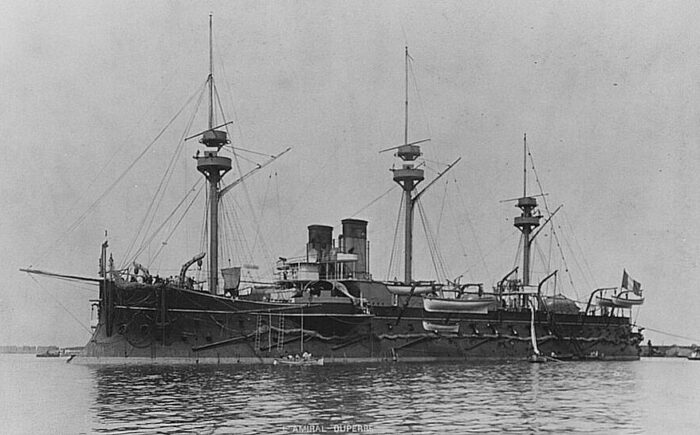
Amiral Duperré was part of the 1889 fleet manoeuvres with six other ironclads as part of the “blue”, French force from 30 June to 6 July. Later that month from 23 July this was done again, swapping on “red” squadron for a simulated attack on Toulon by night and poor weather. Further operations were cancelled the following day. Duperré remained in the 1st Division in 1890 with the two Amiral Baudin-class and in that year’s fleet manoeuvres in the 1st Division, 1st Squadron she was operating with Courbet and Formidable. They were sent off Oran on 22 June and from there proceeded to Brest, on 2 July for combined operations with the Northern Squadron until 25 July. She later returned to Toulon, but in 1892, she operated with there Marceau-class ironclads and took part in the 1893 manoeuvres in the 2nd Division with Amiral Baudin and Hoche, with exercises on 1-10 July, large-scale manoeuvres 17-28 July.
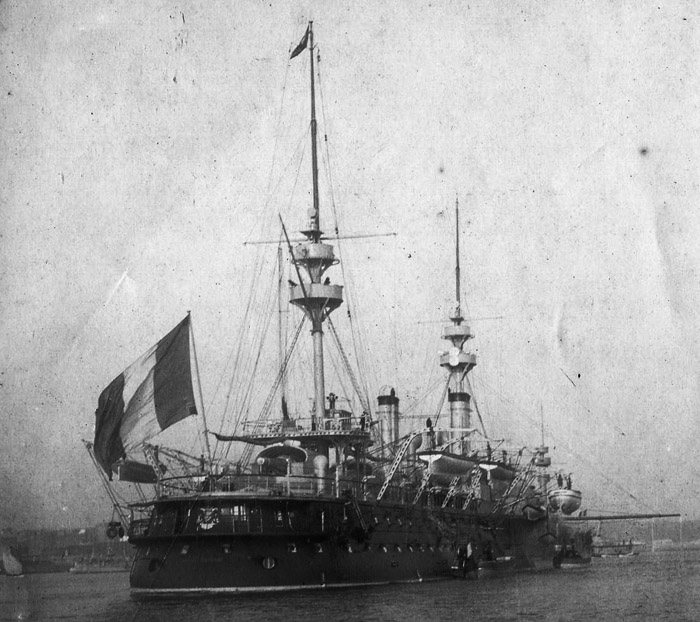
By late January 1895, she was sent with the protected cruiser Sfax in an experimental bombardment on fake coastal fortifications on Levant Island, six hours per day over three days, with studied of the effects each time. Over 1,000 rounds between 10 and 34 cm (3.9 to 13.4 in) were spent, but damage was light or unsignificant. It was concluded that only shell fragments could have inflicted casualties. If the fortification had been returning fire, these attacking ships would have been badly damaged. Amiral Duperré had a magazine on fire and “partly” blowing up on 13 May, indeed only a single shell cooked up, overheated from the adjacent boiler room. The fire was quickly suppressed, so this was nowhere near the disaster that hit later the Battleship Iéna. But the location of the boiler rooms and magazines was a real issue that came in latter designs as well. In 1895, she joined the Reserve Squadron with Richelieu and the Terrible-class ironclads as flagship in 1896-98.
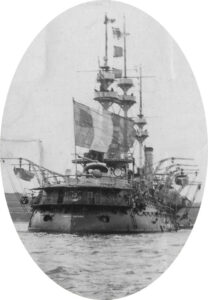 France started to rebuild older ironclads and she was scheduled to be be so modernized after Indomptable and Dévastation. After the fleet maneuvers from 5 to 25 July 1899 and being flagship of Rear Admiral Godin, she was transferred to the Northern Squadron, English Channel from Brest in 1900, with two Amiral Baudins, Dévastation, Courbet, Redoutable, and scheduled again for modernization.
France started to rebuild older ironclads and she was scheduled to be be so modernized after Indomptable and Dévastation. After the fleet maneuvers from 5 to 25 July 1899 and being flagship of Rear Admiral Godin, she was transferred to the Northern Squadron, English Channel from Brest in 1900, with two Amiral Baudins, Dévastation, Courbet, Redoutable, and scheduled again for modernization.
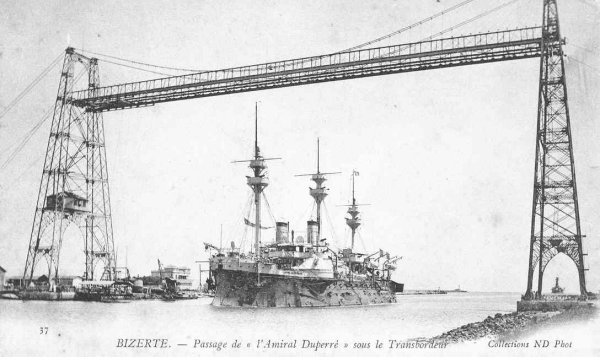
Later Carnot and Masséna joined her in the Squadron as well as Formidable, Redoutable, and Amiral Baudin. In June-July she took part in intensive joint manoeuvres with the Mediterranean Fleet. She operated off Brest in a simulated blockade and mock attacks on Belle Île and Quiberon islands. By early July they joined the Mediterranean Squadron off Lisbon (Portugal) and sailed to Quiberon Bay and entered Brest on 9 July. Amiral Duperré next made a mock attack on Cherbourg on the 11th. She was present for the naval review in Cherbourg on 19 July for President Émile Loubet and a gunnery practice followed on 14 December. However, with the vibrations her forward starboard gun broke free, swung around in heavy swells, stroke the bridge and damaged the fore mast, but there was no injury, and she was repaired.
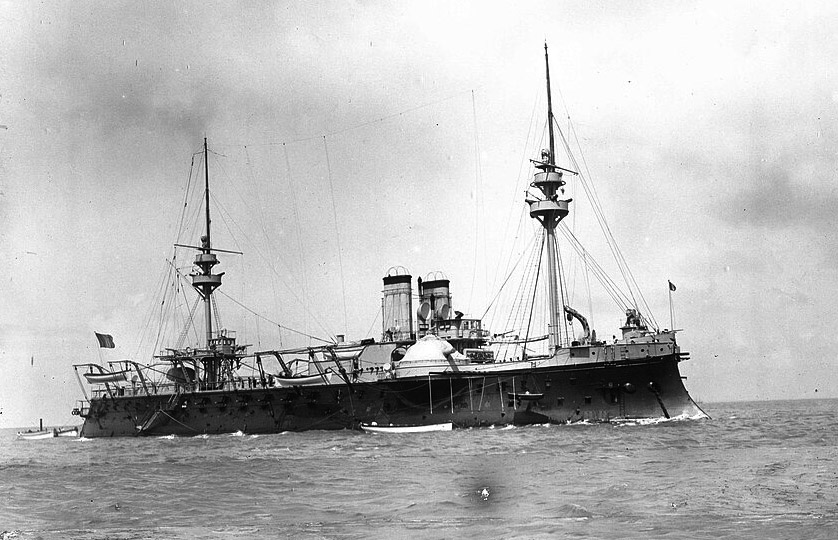
By early 1901 she was withdrawn from service for a modernization in dry-dock, a process that was slow due to poor facilities and lack of funds. It was only completed in 1905 when additional funds were allocated in the budget to complete installation of her new boilers. However by that stage, the marine Nationale estimated there were enough pre-dreadnought battleships to cover the needs of both fleets, so she was placed on the Northern Reserve Division until decommissioned on 20 September 1905, struck on 13 August 1906, after joining the Mediterranean reserve. Condemned on 21 December (stripped down), she was modified to be used as a target ship and sunk off Hyères, southern France, on 31 August 1908. Refloated, she was sunk again on 26 September. She was sold to be salvaged and scrapped on 27 July 1909 to M. Giardino, Marseille, and BU.
Read More/Src
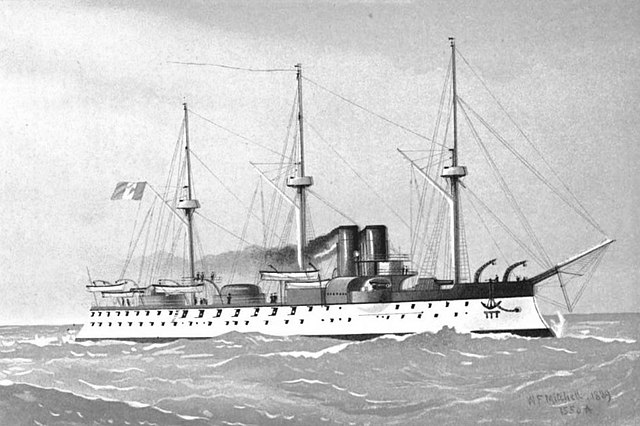
Books
Brassey, Thomas, ed. (1888). “Chapter XV”. The Naval Annual. Portsmouth: J. Griffin & Co.
Brassey, Thomas A. (1893). “Chapter III-IV: Relative Strength”. The Naval Annual. Portsmouth: J. Griffin & Co.
Brassey, Thomas A. & Leyland, John (1905). “Chapter II: Progress of Foreign Navies”. The Naval Annual. Portsmouth: J. Griffin & Co.
Browne, Orde (1897). Brassey, Thomas A. (ed.). “Attack of Coast Batteries by French Ships”. The Naval Annual. Portsmouth: J. Griffin & Co.
Campbell, N. J. M. (1979). “France”. In Gardiner, Robert (ed.). Conway’s All the World’s Fighting Ships 1860–1905.
Jordan, John & Caresse, Philippe (2017). French Battleships of World War One. NIP
Lansdale, Philip V. & Everhart, Lay H. (July 1896). “Notes on Ordnance and Armor”. Notes on the Year’s Naval Progress. XV. Washington, D.C.
Leyland, John (1899). Brassey, Thomas A. (ed.). “Chapter II, III, IX”. The Naval Annual. Portsmouth: J. Griffin & Co.
Leyland, John (1901). “Chapter III: The Progress of Foreign Navies”. The Naval Annual. Portsmouth: J. Griffin & Co.
“Marine Casualties”. Notes on Naval Progress. 20. Washington, D.C.: United States Office of Naval Intelligence. July 1901.
Roberts, Stephen (2021). French Warships in the Age of Steam 1859–1914. Barnsley: Seaforth.
Ropp, Theodore (1987). Roberts, Stephen S. (ed.). The Development of a Modern Navy: French Naval Policy, 1871–1904. NIP
Thursfield, J. R. (1894). Brassey, Thomas A. (ed.). “Foreign Maneouvres: I—France”. Naval Annual. Portsmouth: J. Griffin & Co.
Links
navypedia.org amiral duperre
en.wikipedia.org Amiral Duperré
secretprojects.co.uk/ barbette ironclad study c1870
printsandephemera.com Duperre

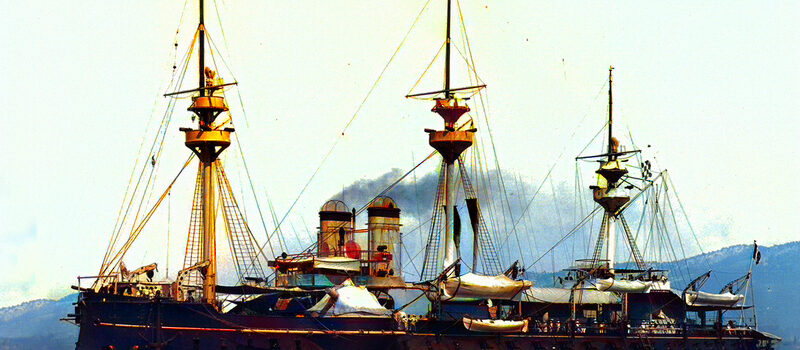

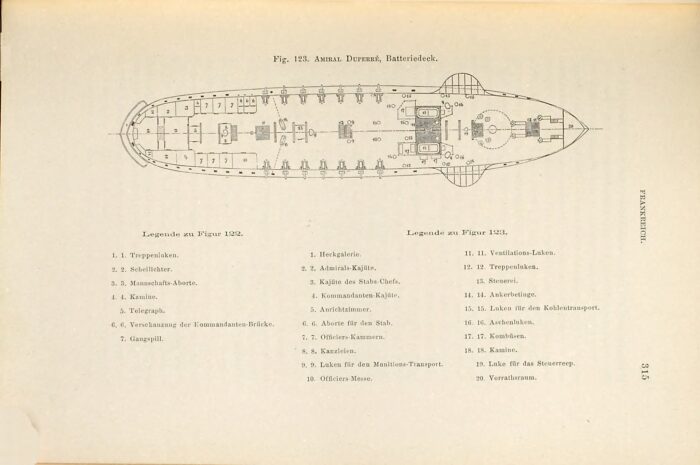
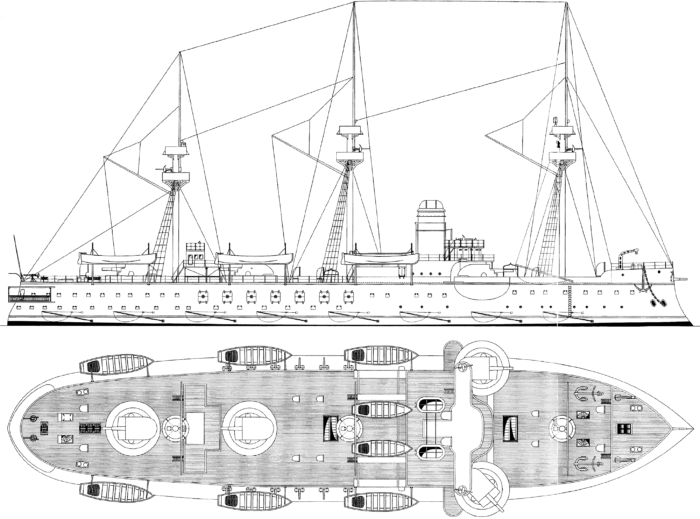
 Latest Facebook Entry -
Latest Facebook Entry -  X(Tweeter) Naval Encyclopedia's deck archive
X(Tweeter) Naval Encyclopedia's deck archive Instagram (@navalencyc)
Instagram (@navalencyc)





 French Navy
French Navy Royal Navy
Royal Navy Russian Navy
Russian Navy Armada Espanola
Armada Espanola Austrian Navy
Austrian Navy K.u.K. Kriegsmarine
K.u.K. Kriegsmarine Dansk Marine
Dansk Marine Nautiko Hellenon
Nautiko Hellenon Koninklije Marine 1870
Koninklije Marine 1870 Marinha do Brasil
Marinha do Brasil Osmanlı Donanması
Osmanlı Donanması Marina Do Peru
Marina Do Peru Marinha do Portugal
Marinha do Portugal Regia Marina 1870
Regia Marina 1870 Nihhon Kaigun 1870
Nihhon Kaigun 1870 Preußische Marine 1870
Preußische Marine 1870 Russkiy Flot 1870
Russkiy Flot 1870 Svenska marinen
Svenska marinen Søværnet
Søværnet Union Navy
Union Navy Confederate Navy
Confederate Navy Armada de Argentina
Armada de Argentina Imperial Chinese Navy
Imperial Chinese Navy Marinha do Portugal
Marinha do Portugal Mexico
Mexico Kaiserliche Marine
Kaiserliche Marine 1898 US Navy
1898 US Navy Sovietskiy Flot
Sovietskiy Flot Royal Canadian Navy
Royal Canadian Navy Royal Australian Navy
Royal Australian Navy RNZN Fleet
RNZN Fleet Chinese Navy 1937
Chinese Navy 1937 Kriegsmarine
Kriegsmarine Chilean Navy
Chilean Navy Danish Navy
Danish Navy Finnish Navy
Finnish Navy Hellenic Navy
Hellenic Navy Polish Navy
Polish Navy Romanian Navy
Romanian Navy Turkish Navy
Turkish Navy Royal Yugoslav Navy
Royal Yugoslav Navy Royal Thai Navy
Royal Thai Navy Minor Navies
Minor Navies Albania
Albania Austria
Austria Belgium
Belgium Columbia
Columbia Costa Rica
Costa Rica Cuba
Cuba Czechoslovakia
Czechoslovakia Dominican Republic
Dominican Republic Haiti
Haiti Hungary
Hungary Honduras
Honduras Estonia
Estonia Iceland
Iceland Eire
Eire Equador
Equador Iran
Iran Iraq
Iraq Latvia
Latvia Liberia
Liberia Lithuania
Lithuania Mandchukuo
Mandchukuo Morocco
Morocco Nicaragua
Nicaragua Persia
Persia San Salvador
San Salvador Sarawak
Sarawak Uruguay
Uruguay Venezuela
Venezuela Zanzibar
Zanzibar Warsaw Pact Navies
Warsaw Pact Navies Bulgaria
Bulgaria Hungary
Hungary

 Bundesmarine
Bundesmarine Dutch Navy
Dutch Navy Hellenic Navy
Hellenic Navy Marina Militare
Marina Militare Yugoslav Navy
Yugoslav Navy Chinese Navy
Chinese Navy Indian Navy
Indian Navy Indonesian Navy
Indonesian Navy JMSDF
JMSDF North Korean Navy
North Korean Navy Pakistani Navy
Pakistani Navy Philippines Navy
Philippines Navy ROKN
ROKN Rep. of Singapore Navy
Rep. of Singapore Navy Taiwanese Navy
Taiwanese Navy IDF Navy
IDF Navy Saudi Navy
Saudi Navy Royal New Zealand Navy
Royal New Zealand Navy Egyptian Navy
Egyptian Navy South African Navy
South African Navy






























 Ukrainian Navy
Ukrainian Navy dbodesign
dbodesign